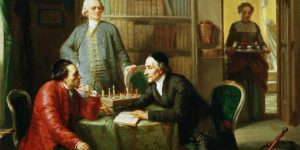“Belonging: The Story of the Jews: 1492-1900”
Simon Schama: the arch showman of Jewish history
reviewed by Deborah Maccoby, December 2017. The Bodley Head, London
2017. The Bodley Head, London
The Story of the Jews was conceived simultaneously as a TV series and a book, with the book being based upon the highly successful 2013 TV series.
Volume 1, The Story of the Jews: Finding the Words: 1000 BCE to 1492 CE, came out in 2013. Volume 2, entitled When Words Fail, was due to appear in September 2014, but its words failed to materialise at that time. After a three-year delay, Volume 2 has now appeared, but under a new title — Belonging. The book brings the story up to 1900 — to be completed in a third volume still to come.
The central theme of Volume 1 was that the true and eternal homeland of the Jews is the Book, the Jews being very aptly called “The People of the Book”; the indestructibility of the Book was seen as one of the main reasons for the survival of the People in the face of terrible adversity.
However, the original title of Volume 2 – When Words Fail – implied that it would show the ultimate failure of the Book – and of words in general — to guarantee the safety of the People, who would thus be forced to acknowledge that they needed a physical homeland – a State of their own. In a nutshell, this looked like a Zionist story. Despite the new title, this is indeed the overall story of Volume 2.
“Delusion and fanaticism act, while all reason does is talk”.
The title is clearly ironic. After the massacres and expulsions of the Middle Ages that ended Volume 1, Volume 2 takes us through the Renaissance — during which, together with the rediscovery of Greek and Roman culture, there was a renewed interest in the Hebrew Bible and Judaism — and the Enlightenment, which saw the emancipation of the Jews from the ghettoes and mediaeval restrictions. The high point of the sense of belonging was the friendship between Moses Mendelssohn and Gotthold Lessing. But Schama writes in the chapter devoted to this friendship: “Sometimes words misbehave” and quotes from Mendelssohn, whom he describes as being “at a loss for words” when faced with the re-emergence of fanatical hatred of Jews: “Delusion and fanaticism act, while all reason does is talk”.
In the book’s final chapter, Theodor Herzl concludes that “emancipation had failed…..there was only one salvation. Home.”
Schama espouses several clichés of the Zionist historian. During a brief account of Jews in the Muslim world, he writes:“There exists today a romance of Jewish life in the Muslim world, imagined as one of neighbourly harmony, irremediably altered by the rise of Zionism and the creation of Israel.”
Schama conveys the impression that there was little to choose between Muslim and Christian treatment of Jews; thus much emphasis is placed on the public beheading in Fez in 1834 of Sol Hachuel, a beautiful Jewish girl who refused to convert to Islam after being unjustly convicted of apostasy from it, and on the 1840 Damascus blood libel affair. But Schama’s presentation is contradicted by Bernard Lewis (no subscriber to any idealised “romance” about the subject) in his book Semites and Anti-Semites, where he writes of Jews in the Muslim world: ““their situation was never as bad as in Christendom at its worst, nor ever as good as in Christendom at its best….most of the characteristic and distinctive features of Christian antisemitism were absent…even the blood libel did not appear among Muslims until it was introduced to the conquering Ottomans by their newly-acquired Greek subjects in the fifteenth century.”
Another Zionist cliché is Schama’s implication that most Palestinian Arabs migrated to the Holy Land in the nineteenth century from Egypt, Algeria, Morocco, Syria and Lebanon: “The whole of Palestine…was full of Arab immigrants”.
But in his book The Invention of the Jewish People, Shlomo Sand points out that several early Zionist historians, including David Ben-Gurion, found convincing evidence that Palestinian Arabs – even allowing for waves of immigration — are mostly descended from the Jewish peasantry of ancient times. Sand quotes the early Zionist historian Itzhak Ben-Zvi: ““Obviously it would be mistaken to say that all the fellahin are descendants of the ancient Jews, but it can be said of most of them, or their core”. Sand writes that it was only after it became evident that the indigenous population intended to resist integration with Zionism that the viewpoint of Zionist historians changed: “Very soon, the modern Palestinian fellahin became, in the eyes of the authorized agents of memory, Arabian immigrants who came in the nineteenth century to an almost empty country and continued to arrive in the twentieth century as the developing Zionist economy, according to the new myth, attracted many thousands of non-Jewish labourers”.
The “new myth” having been discredited by the demolition of Joan Peters’ book From Time Immemorial by scholars such as Norman Finkelstein and Yehoshua Porath, Schama has reverted to the old myth.
But within the overall simplistic Zionist story, Belonging consists of many fascinating tales about Jewish individuals during Renaissance and Enlightenment times. Schama’s attitude is: the sense of belonging was an illusion, but there is still a lot to celebrate. As he said in a recent Guardian interview: “Wherever you look, the dawns are false. But the morning that follows the dawn can last a very long time”.
Schama seeks on the whole to escape from religious history: “There were of course the upholders of tradition….but then there were the rest of the Jews”. The book is mainly about “the rest of the Jews”. The result is an exuberant collection of picaresque tales about a dazzlingly varied cast of characters, across the globe and across four centuries.
The Jewish enlightenment: Moses Mendelssohn, R, with guests Gotthold Lessing, standing, and Swiss poet Jahann Kaspar
Jews are seen as “the impresarios of modernity”
Varied though the characters are, there is one quality that links most of them: showmanship. We meet Leone de Sommi Portaleone, known as Leone Ebreo, a 16th century Mantuan actor and theatre director; Jacob Judah Leon, known as “Templo”, “the first showman of the Bible”, who made a model Temple in 17th century Amsterdam; Daniel Mendoza, the 18th century Anglo-Jewish boxer, “who created the first thoroughly marketed sports celebrity cult”; Giacomo Meyerbeer, the German composer of the 19th century – “the first and most successful showman” of musical performance. Jews are seen as “the impresarios of modernity”. Herzl, whose background as a dramatist is emphasised, is seen as “the dramaturge of a Jewish-national awakening”.
The chapter on the Dreyfus Affair opens with a description of film shorts that were made at the time about the case: “One way or another, the Jews and the movies were destined to come together”. By this point, the People of the Book seem to have morphed into the People of the Screen. It is clear that Volume 3 will focus on Hollywood as well as on the Holocaust and Israel.
The characters in Belonging are chosen in Schama’s own image. He himself is the arch-showman of Jewish history: Schama the Showman. The all-pervasiveness of Schama’s own personality works in the TV series, but in a written history we would expect the historian himself to take more of a back seat. But this is not a conventional history.
In a written history, the reader also becomes aware of errors. Schama seems too concerned with glittering showmanship to bother too much about accuracy of detail. In a review of the book in the TLS, Abigail Green wrote: “Any scholar who cares about Jewish history will forgive Simon Schama the odd error or omission, for this is a book that transcends the normal conventions of academic criticism.”
Carping though it may appear to mention just one of these errors, Schama presents an inaccurate version of the origin of the Board of Deputies of British Jews. He writes of the British Sephardi and Ashkenazi communities: “When George III succeeded to the throne in 1760, the two communities combined to form a ‘Board of Deputies’ to make representations to the government and inaugurated its duties by presenting ceremonial congratulations to the new monarch”.
But, according to both Cecil Roth, in his book A History of the Jews in England, and the Board of Deputies’ own website, the real story goes: in 1760, the Sephardi community elders appointed a delegation of seven “deputados” to present a loyal address to George III on the occasion of his accession to the throne. The Ashkenazi community (who, Roth writes, “though more numerous, were less assimilated and (with a few brilliant exceptions) came from a lower social stratum”) made a formal statement of protest to the Sephardic elders about being left out, and shortly afterwards formed their own “German Secret Committee for Public Affairs”. The two committees began to meet on an informal, ad hoc basis to discuss matters of importance to the Jewish community as a whole until they finally joined formally into one body in the early nineteenth century. As well as being accurate, this makes a better and more typically Jewish story, especially as Schama writes elsewhere in Belonging about friction between Sephardi and Ashkenazi communities.
But the book raises interesting questions about the meaning of belonging. To Schama, the very belongingness of the Jews in Europe during these four centuries – their centrality to modern life after their release from the ghettoes – ironically helped to bring about the revival of antisemitism, since Jews were blamed for the ills of modernity. Schama also asks, as he puts it in his JC interview: “If you go so far towards the host community, how do you retain a core sense of belonging to both the host community and your Jewish identity?”
On the whole, however, apart from the overall Zionist message, Belonging is short on analysis and explanatory theories – it is mainly narrative and descriptive. To sum up: this is a spectacular but superficial fireworks display of a book – a 700-page blockbuster, sumptuously produced and lavishly illustrated; ideal for the Chanukah/Christmas gift market and the coffee table.

